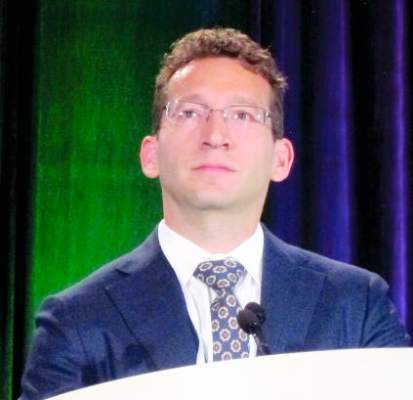AT OBESITY WEEK 2016
NEW ORLEANS (FRONTLINE MEDICAL NEWS) – About one-third of bariatric surgery patients achieve a body mass index below 30 kg/m2 at 1 year of follow-up, and the strongest predictor of success is having a BMI of 40 kg/m2 or less at the time of surgery, Oliver A. Varban, MD, reported at Obesity Week 2016.
Indeed, patients with a baseline BMI of 40 kg/m2 or less were fully 13.3-fold more likely to have a BMI of less than 30 kg/m2 1 year post surgery in a study of 19,764 patients in the Michigan Bariatric Surgery Collaborative database, according to Dr. Varban, surgical director of the adult bariatric surgery program at the University of Michigan, Ann Arbor.
“In order to optimize outcomes of bariatric surgery, patients should be encouraged to consider it when their BMI is less than 40 kg/m2. And policies that obstruct or delay surgery can actually result in inferior outcomes,” he said at the meeting, which was presented by the Obesity Society and the American Society for Metabolic and Bariatric Surgery.
Dr. Varban said this was a study conducted primarily to inform and, hopefully, influence the behavior of referring physicians.
“These patients are being referred to us. We don’t seek them out. The biggest impetus for this study was to be able to show referring physicians that outcomes are better when treatment is sought earlier. Every patient who shows up at our clinics with a BMI of 65 must have had a BMI of 35 at some point in time. I think we miss the boat on a lot of those patients,” the surgeon said. “Society at large should recognize that bariatric surgery is the most effective treatment for obesity, but it’s also the most underutilized one.”
The Michigan Bariatric Surgery Collaborative is a unique statewide, payer-funded consortium focused on quality improvement. Dr. Varban presented an analysis of 19,764 patients who underwent a primary bariatric procedure in Michigan during 2006-2015 for whom complete 1-year follow-up data were available. The mean preoperative BMI for the overall group was 48 kg/m2, and the mean postoperative BMI at 1 year was 33 kg/m2.
Thirty-eight percent of patients achieved a BMI below 30 kg/m2 at 1 year; their mean BMI at that time was 26.7 kg/m2. The mean BMI 1 year post surgery in the 62% of patients who didn’t reach the goal was 36.7 kg/m2.
Only 6.2% of patients who didn’t get to a BMI of less than 30 kg/m2 1 year post surgery had a preoperative BMI of 40 kg/m2 or below, whereas 31.7% of patients who achieved the goal did have a baseline BMI of 40 kg/m2 or below.
Among patients with a preoperative BMI of 50-59 kg/m2, only 7.6% reached the target. And among those with a preoperative BMI of 60 kg/m2, only 0.4% had a BMI of less than 30 kg/m2 at 1 year.
“Patients with a BMI of 50 kg/m2 or more should be given realistic expectations about the type of weight loss they’ll have after bariatric surgery,” Dr. Varban said.
Why is a postsurgical BMI below 30 kg/m2 such an important benchmark? Abundant evidence indicates that having a BMI of 30 kg/m2 or higher is associated with a 50%-100% increase in the risk of premature death compared to that of normal-weight individuals. Successful bariatric surgery reduces that risk by 30%-40%.
In the Michigan study, patients who reached the BMI target had a significantly higher rate of resolution of common comorbid conditions associated with morbid obesity, including type 2 diabetes, hypertension, dyslipidemia, and sleep apnea. They also scored higher on a patient satisfaction survey.
The mean percent preoperative weight loss was 2.3% in patients who didn’t achieve the target BMI and similar at 2.5% in those who did. Thus, preoperative weight loss is not a major contributor to postoperative success, Dr. Varban continued.
Failure to reach the postoperative BMI goal was significantly more common among patients who were black or Hispanic, had an annual income below $25,000, or didn’t have private insurance.
Thirty-day perioperative complication rates didn’t differ between patients who attained a BMI below 30 kg/m2 at 1 year and those who did not.
Dr. Varban said it will come to no surprise to bariatric surgeons that the likelihood of attaining the target 1-year BMI varied according to the type of bariatric surgery: Compared to patients who underwent adjustable laparoscopic banding, the success rate was 19-fold higher with Roux-en-Y gastric bypass, 7.2-fold higher with sleeve gastrectomy, and a whopping 72-fold higher in patients who had a duodenal switch procedure.
Neither the mean preoperative nor 1-year postoperative BMI figures changed much over the study period, even though sleeve gastrectomy became much more common after 2010. For example, the mean preoperative BMI was 48.3 kg/m2 in 2006 and 46.9 kg/m2 in 2015, while the mean postoperative BMIs were 32.7 and 32.6 kg/m2, respectively, in those years.
Dr. Varban said that as he ran the numbers, he was surprised to see that the baseline BMI was so high – far higher than he would have guessed. But since then as he has discussed the study findings with referring physicians throughout Michigan, he’s come to understand the explanation: Many of them are content to wait until their morbidly obese patients grow to a BMI above 50 kg/m2 before making the referral because they consider the alternate criterion for bariatric surgery referral – that is, failure to achieve significant weight loss after 1 year of medically supervised attempts – to be too much for them to take on.
Amir A. Ghaferi, MD, a University of Michigan bariatric surgeon and coinvestigator in the study, rose from the audience to urge his colleagues to focus on the health policy implications of the findings.
“Maybe our bariatric surgery criteria aren’t right. We’ve been talking a lot amongst ourselves about pushing the BMI threshold lower and reducing some of the insurance barriers. I think what this study demonstrates from a policy perspective is we need to get these patients sooner, without so many barriers ahead of us and in front of the patients, in order to achieve the best possible outcomes,” Dr. Ghaferi said.
Dr. Varban reported receiving research funding from Blue Cross Blue Shield of Michigan.





